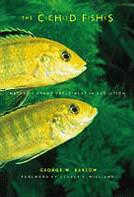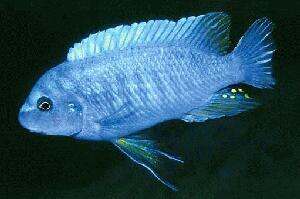

George Barlow's book on cichlid fishes and their evolution is a delight to read. Barlow, is Professor Emeritus in the Dept. of Integrative Biology at the Univ. of California in Berkeley. He makes no bones about tailoring the book for a lay audience, although it contains a wealth of easily readable scientific data.

This is one of about 30 color plates from the book, which also contains many nice pen-and-ink drawings. Labeotropheus fuelleborni (a male is shown here) is an Aufwuchs-scraping cichlid from Lake Malawi. It displays egg spots on the anal fin.
|
|
Chapter Outline of the Book
|
|
1. So, What Is A Cichlid? The diversity of fishes and how they relate to one another, with cichlids placed into the scheme of things and characterized.
2. Jaws Two. The multiplicity of cichlid diets, from eating plants to devouring other cichlids, followed by a description of how the outer jaws collaborate with the uniquely dexterous throat jaws.
3. Plastic Sex. When, why and how fishes change sex as adults, with some examples from cichlid fishes.
4. Mating Games. The theoretical issue of conflict between the sexes and how that applies to cichlids, plus a classification of their many mating systems.
5. Oh Yea, Put Up Your Fins. When, why and how cichlids fight.
6. Cichlid Speak. How cichlids communicate, including dynamic color signals, displays and sounds.
7. Beauty is Only Fin Deep. In these cichlid mating systems, males and females don�t get to know one another. They meet briefly, spawn, and part. How do females choose males, and why should they care?
8. Mating Gets Personal. The basic mating system in cichlids is monogamy, in which males and females carefully choose one another and form enduring personal bonds.
9. How Gametes Meet. How sperm reach eggs varies among mating systems. One of the most challenging situations arises when the female takes her spawned eggs into her mouth before they are fertilized.
10. Family Plan. Cichlids universally care for their offspring but to remarkably different degrees and ways. Some carry eggs in their mouths and some guide schools of young for up to several months, and the young of yet others eat the surface of their parents.
11. Family Life Gets Complicated. Young are placed up for adoption, some catfish parasitize parents, other catfish become baby sitters. Rarely, young cichlids stay home to help out around the house.
12. Cichlid Factories. The massive and rapid production of hundreds of species in the Great Lakes of Africa has stunned evolutionary biologists. How have cichlids done that?
13. Fish At Risk. All fisheries in the world are over exploited, and fish farming � aquaculture � brings its own problem. Cichlids are endangered in many places, especially in Lake Victoria where hundreds of species may already have been lost.
|
|
Cichlids Elsewhere on the Internet
|
|
African Cichlids - Malawi, Tanganyika and Victoria : This is a commercial site with a lot of quality information about Rift Lake Cichlids.
The Cichlid Fishes of Lake Malawi, Africa : This is a scientifically oriented, noncommercial site devoted to a fascinating trove of tropical biodiversity � both the largest lake-fish fauna and the largest vertebrate species flock on earth � the cichlids of southeastern Africa's Lake Malawi.
Classical Species Radiations : Part of a course in biology, examples given include Galapagos finches, Hawaiian honeycreepers, Hawaiian Drosophila and Cichlid fishes of the great lakes of Africa.
The Cichlid Room Companion : You may find different points of view in several documents found here, but they all have valid points and all will help you develop a sound knowledge on the topics presented This site will take you from fairly basic Cichlid information to a solid reference for research and taxonomy.
Cichlid Research Home Page : A web site dedicated to collaboration between scientists and hobbyists interested in cichlid fishes (family Cichlidae), featuring extensive information about cichlids, plus the online science experiment known as the Cichlid Egg Project. The Links page at this website is worth the visit.
George Barlow's Cichlid Book : This is at Dr. Barlow's academic website. You can find out more about him and his research interests.
FishBase: Cichlidae Taxonomy : This standard web reference for data about fishes maintains only a conservative list of cichlid species.
How Old is Lake Victoria : From the Cichlid Room Companian, an interpretive report based upon Johnson, T. C. et al.: Late Pleistocene dessication of Lake Victoria and rapid evolution of cichlid fishes, in Science 273:1091-1093, 1996.
The Last Minutes of Speciation : An article that offers some tantalizing, though possibly speculative, information about recent cases of rapid speciation in cichlids. From the Chichlid Room Companion archives.
Cichlid Research Page : of Peter Smith & Irv Kornfield, University of Maine, Orono
|
|
References for Further Research
|
|
Albertson, R. C. et al. : Phylogeny of a Rapidly Evolving Clade: The Cichlid Fishes of Lake Malawi, East Africa. (adaptive radiation / sexual selection / speciation / amplified fragment length polymorphism / lineage sorting). Proceedings National Academy of Science Vol. 96, Issue 9, 5107-5110, April 27, 1999
Johnson, E. T. et al. : "Late Pleistocene Desiccation of Lake Victoria and Rapid Evolution of Cichlid Fishes. Lake Victoria is the largest lake in Africa and harbors more than 300 endemic species of haplochromine cichlid fish. Seismic reflection profiles and piston cores show that the lake not only was at a low stand but dried up completely during the Late Pleistocene, before 12,400 carbon-14 years before the present. These results imply that the rate of speciation of cichlid fish in this tropical lake has been extremely rapid." This is the abstract of a technical paper that appeared in Science 273: 1091-1093, 23 August 1996. See also How Old is Lake Victoria, from the Cichlid Room Companian, an interpretive report based on this paper.
Lowe-McConnell, R. : Fish Faunas of the African Great Lakes: Origins, Diversity and Vulnerability. Conservation Biology 7:634-643, 1993.
Meyer, A. : Phylogenetic Relationships and Evolutionary Processes in East African cichlid fishes. Trends in Ecology and Evolution 8:279-284, 1993.
Sturmbauer, C. and A. Meyer. : Genetic Divergence, Speciation and Morphological Stasis in a Lineage of African Cichlid Fishes. Nature 358:578-581, 1992.
Worthington, E. and R. Lowe-McConnell. : African Lakes Reviewed: Creation and Destruction of Biodiversity. Environmental Conservation 21:199-213, 1994.
|




